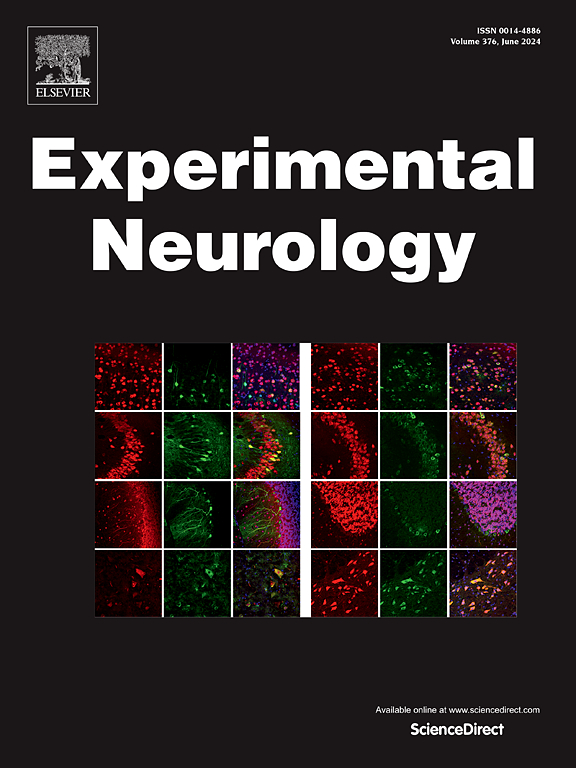血肿抽吸缓解严重脑出血线粒体功能障碍和神经炎症的新手术模式。
IF 4.6
2区 医学
Q1 NEUROSCIENCES
引用次数: 0
摘要
背景:脑出血(ICH)与大血肿相关,可导致压迫、颅内压升高(IICP)、中线移位和脑疝,最终可能导致死亡。紧急手术切除大血肿可以改善这些损伤,这将挽救生命,但并没有改善临床结果。迫切需要一种合适的动物模型来模拟临床相关的人类严重脑出血损伤,需要手术血肿清除。在此,我们建立了一种新的大鼠重度脑出血模型,允许血肿抽吸,并研究线粒体功能障碍对脑出血的影响。方法:以3 μl无菌生理盐水为溶液,纹状体内注射0.6 U胶原酶,15 min诱导重度脑出血。在诱导严重脑出血6 小时后,抽吸约占总血肿的75% %。测量血肿吸入对大鼠血肿体积、死亡率、氧化应激、ATP水平、线粒体功能障碍和神经功能的影响。结果:严重的脑出血诱导增加血肿体积、神经功能缺损和死亡率。血肿抽吸降低了死亡率,显著减少了血肿体积和神经功能缺损。此外,血肿吸入改善了线粒体功能障碍,线粒体功能障碍是导致能量产生失败和过度氧化应激相关的严重出血性损伤。血肿吸入也调节线粒体生物发生和线粒体自噬,从而促进线粒体稳态。神经炎症标志物,包括iNOS、MMP9和MPO,在严重脑出血患者中升高,但在血肿抽吸后减弱。结论:本研究建立了严重脑出血动物模型,为了解严重脑出血复杂的发病机制提供了有价值的见解。结果显示血肿抽吸有效改善线粒体功能障碍、氧化应激和神经炎症,突出了其作为治疗干预的潜力。本文章由计算机程序翻译,如有差异,请以英文原文为准。
Mitigating mitochondrial dysfunction and neuroinflammation by hematoma aspiration in a new surgical model for severe intracerebral hemorrhage
Background
Intracerebral hemorrhage (ICH) is associated with a large hematoma that causes compression, increased intracranial pressure (IICP), midline shift, and brain herniation, and may ultimately lead to death. Urgent surgical removal of the large hematoma can ameliorate these injuries, which would be life-saving, but has not improved clinical outcome. A suitable animal model that mimics the clinically relevant human severe ICH injury requiring surgical hematoma evacuation is urgently needed. Here, we established a novel model of severe ICH in rats allowing aspiration of the hematoma and studying the effects of mitochondrial dysfunction in ICH.
Methods
Severe ICH was induced by intra-striatal injection of 0.6 U of collagenase in 3 μL sterile saline over 15 min. Aspiration of approximately 75 % of the total hematoma was performed 6 h after induction of severe ICH. The effects of hematoma aspiration on hematoma volume, mortality, oxidative stress, ATP levels, mitochondrial dysfunction, and neurological function were measured in rats.
Results
Severe ICH induction increased hematoma volume, neurological deficits, and mortality. Hematoma aspiration abolished mortality and significantly reduced hematoma volume, and neurological deficits. In addition, hematoma aspiration ameliorated the pronounced mitochondrial dysfunction responsible for the failure of energy production and excessive oxidative stress associated with severe hemorrhagic injury. Hematoma aspiration also modulated mitochondrial biogenesis and mitophagy, thereby promoting mitochondrial homeostasis. Markers of neuroinflammation, including iNOS, MMP9, and MPO, were elevated in severe ICH but attenuated by hematoma aspiration.
Conclusion
This study established an animal model of severe ICH and provides valuable insights into the complex pathogenesis of severe ICH. The results showed that hematoma aspiration effectively ameliorates mitochondrial dysfunction, oxidative stress, and neuroinflammation, highlighting its potential as a therapeutic intervention.
求助全文
通过发布文献求助,成功后即可免费获取论文全文。
去求助
来源期刊

Experimental Neurology
医学-神经科学
CiteScore
10.10
自引率
3.80%
发文量
258
审稿时长
42 days
期刊介绍:
Experimental Neurology, a Journal of Neuroscience Research, publishes original research in neuroscience with a particular emphasis on novel findings in neural development, regeneration, plasticity and transplantation. The journal has focused on research concerning basic mechanisms underlying neurological disorders.
 求助内容:
求助内容: 应助结果提醒方式:
应助结果提醒方式:


